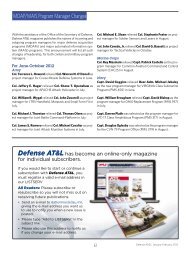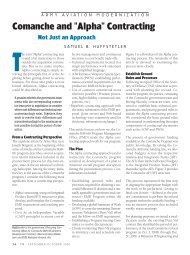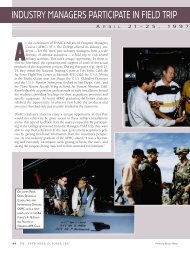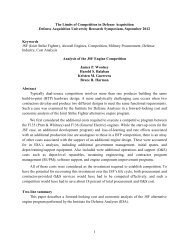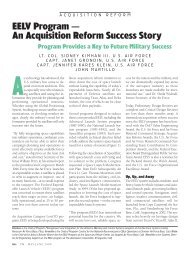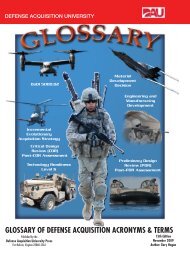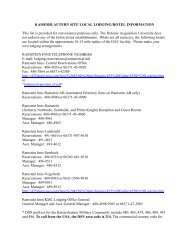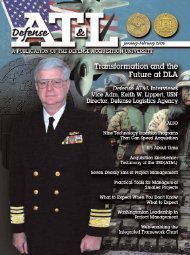DAU to Offer New Program Management Office Course - Defense ...
DAU to Offer New Program Management Office Course - Defense ...
DAU to Offer New Program Management Office Course - Defense ...
- TAGS
- www.dau.mil
You also want an ePaper? Increase the reach of your titles
YUMPU automatically turns print PDFs into web optimized ePapers that Google loves.
ACQUISITION EDUCATION, TRAINING, AND<br />
CAREER DEVELOPMENT<br />
<strong>DAU</strong> <strong>to</strong> <strong>Offer</strong> <strong>New</strong> <strong>Program</strong><br />
<strong>Management</strong> <strong>Office</strong> <strong>Course</strong> (PMOC)<br />
DoD Level III <strong>Program</strong> <strong>Management</strong> Certification<br />
Enters the 21 st Century<br />
Students who attended the <strong>Defense</strong><br />
Systems <strong>Management</strong> College<br />
<strong>to</strong> complete the 20-week<br />
<strong>Program</strong> <strong>Management</strong> <strong>Course</strong><br />
(PMC) can readily recall both the<br />
hard work required of the course and<br />
the comradery with their classmates.<br />
They fondly remember building the<br />
wooden mousetrap vehicle, striving <strong>to</strong><br />
meet both the technical and performance<br />
requirements of the runoff.<br />
When the course was reduced <strong>to</strong> 14<br />
weeks and renamed the Advanced <strong>Program</strong><br />
<strong>Management</strong> <strong>Course</strong>, or APMC<br />
(Figure 1), students moved from building<br />
the old mousetrap vehicles <strong>to</strong> building<br />
a pro<strong>to</strong>type of an Unmanned<br />
Ground Vehicle (UGV) using Lego<br />
Minds<strong>to</strong>rms. The course required students<br />
<strong>to</strong> design, build, and program the<br />
software for the Lego Minds<strong>to</strong>rms’ vehicle<br />
so that it could successfully negotiate<br />
through a difficult obstacle course.<br />
A <strong>New</strong> Beginning<br />
Beginning in 2002, students will complete<br />
the <strong>Program</strong> <strong>Management</strong> <strong>Office</strong><br />
<strong>Course</strong> (PMOC) using an advanced version<br />
of Lego Minds<strong>to</strong>rms <strong>to</strong> design the<br />
UGV online, build it, and then test it on<br />
a simulated battlefield. The course number<br />
is <strong>Program</strong> <strong>Management</strong> Training<br />
(PMT-352). This is part of <strong>DAU</strong> President<br />
Frank Anderson’s Fast-Track Initiatives,<br />
specifically, “Revision of PM<br />
Training Curriculum,” first published<br />
in Oc<strong>to</strong>ber 2000.<br />
Bloom is the industry Project Manager for PMT 352 development at the <strong>Defense</strong> Acquisition University (<strong>DAU</strong>), Fort Belvoir, Va. Based in Detroit, Mich., he is employed<br />
by Accenture. Bahnmaier is a Professor of Acquisition <strong>Management</strong> with the <strong>Program</strong> <strong>Management</strong> and Leadership Department of the <strong>DAU</strong><br />
Capital/Northeast Regional Campus at Fort Belvoir, Va. Currently, he is serving as <strong>DAU</strong>’s <strong>Course</strong> Manager for PMT 352 development and delivery.<br />
76<br />
PM : JANUARY-FEBRUARY 2002<br />
KEN BLOOM BILL BAHNMAIER<br />
FIGURE 1. DAWIA Certification—Old Level III vs. <strong>New</strong> Level III<br />
Old Level III <strong>New</strong> Level III<br />
PMT 302 (APMC)<br />
– 14 Week Classroom-Based<br />
– Tied <strong>to</strong> Ft. Belvoir Campus<br />
– “S<strong>to</strong>ve-piped” Content<br />
(11 Departments)<br />
– Lecture/Discussion Focus<br />
– Cases/Exercises Functionally<br />
Oriented<br />
– Independent Assessments<br />
by 11 Departments<br />
<strong>Defense</strong> Acquisition University, assisted<br />
by Accenture, is working <strong>to</strong> incorporate<br />
computer-aided design technology, simulation-based<br />
trade-off software, and<br />
risk analysis programs in<strong>to</strong> Lego Minds<strong>to</strong>rms.<br />
Figure 2 represents the Joint Reconnaissance<br />
and Au<strong>to</strong>nomous Targeting<br />
System (JRATS), which is a system of<br />
systems used throughout the course <strong>to</strong><br />
Mobile JCCS<br />
Controller (MJC)<br />
PMT 352 (PMOC)<br />
– Hybrid <strong>Course</strong> Delivery<br />
50 Hours Distance Learning<br />
6 Week Classroom-Based<br />
– Exportable <strong>to</strong> Cus<strong>to</strong>mer Locations<br />
– Integrated Content–Scenario Focus<br />
– Cases/Exercises Integrated with<br />
Scenario<br />
– Integrated Assessment<br />
Approach<br />
emphasize interoperability and information<br />
superiority.<br />
JRATS involves UGV alternatives, an Unmanned<br />
Aerial Vehicle (UAV) called<br />
“Firebird,” and a Joint Command and<br />
Control System (JCCS).<br />
Hold on <strong>to</strong> your joystick because the virtual<br />
battlefield is only one aspect of this<br />
newly structured course. <strong>DAU</strong> has taken<br />
FIGURE 2. Joint Reconnaissance and Au<strong>to</strong>nomous Targeting<br />
System (JRATS)<br />
Joint Command &<br />
Control System (JCCS)<br />
LEGO® Minds<strong>to</strong>rms<br />
Unmanned Ground Vehicles<br />
Firebird UAV
great care <strong>to</strong> design PMT-352 (PMOC)<br />
with the student in mind (Figure 3).<br />
Hybrid <strong>Course</strong> Design<br />
PMT-352 (<strong>New</strong> Level III, Figure 1) is<br />
the final required course for over 90 percent<br />
of personnel in the <strong>Program</strong> <strong>Management</strong><br />
Career Field.<br />
The new course better meets the needs<br />
of the student while producing more effective<br />
Level III PM career field professionals.<br />
Graduates will be able <strong>to</strong> capably<br />
serve as senior <strong>Program</strong> <strong>Management</strong><br />
<strong>Office</strong> (PMO) Integrated Product Team<br />
(IPT) leaders and members.<br />
The PMT-352 course design team conducted<br />
field-level assessments at locations<br />
with high concentrations of Acquisition,<br />
Technology, and Logistics<br />
(AT&L) personnel. Data gathered during<br />
the field assessments shaped both<br />
the mix and duration of Distance Learning<br />
(DL) and classroom learning for the<br />
course. These assessments reported that<br />
field personnel like the freedom of DL,<br />
but believe that face-<strong>to</strong>-face teaming is<br />
required for the intricate nature of the<br />
course exercises.<br />
The information gathered from the field<br />
assessments—along with the course performance<br />
outcomes, student responsibilities,<br />
and the DoD culture—resulted<br />
in the hybrid course design concept,<br />
FIGURE 3. PMT-352 <strong>Course</strong> Structure<br />
Distance Learning<br />
Distance Learning<br />
Learning Modules:<br />
- Science & Technology<br />
- Leadership<br />
- International<br />
- Design Considerations<br />
- Sustainment<br />
- Software Acquisition<br />
- IT & Info Assurance<br />
- Business Aspects<br />
- Environmental, Safety<br />
& Occupational Health<br />
50 hrs<br />
Exploring<br />
the<br />
Concepts<br />
Exercise 1<br />
Technology<br />
Opportunity,<br />
User Needs<br />
Exercise 2<br />
Transition<br />
Strategy<br />
Planning &<br />
Solicitation Prep<br />
for Demo<br />
Contract<br />
Over 700 students<br />
are expected <strong>to</strong><br />
complete PMT-352<br />
each year.The<br />
student pilot will be<br />
conducted in<br />
January 2002, with<br />
the first course<br />
offering scheduled<br />
for June 2002.<br />
blending the appropriate mix of DL and<br />
classroom instruction.<br />
Web-Based Training<br />
If you’ve ever taken a DL course and<br />
found yourself yawning through each<br />
page of material, you are in for a pleasant<br />
awakening. PMT-352 delivers its online<br />
content via exciting interactions and<br />
activities <strong>to</strong> keep you engaged.<br />
PMT-352 begins with 50 hours of Webbased<br />
DL that students complete over<br />
a 60-day period. The 60-day period allows<br />
maximum flexibility for students<br />
<strong>to</strong> complete the material at their own<br />
pace, wherever and whenever they wish.<br />
Pre-Systems Acquisition<br />
Defining &<br />
Demonstrating<br />
the Concept<br />
Exercise 3<br />
Review of<br />
Alternatives<br />
and Project<br />
Planning<br />
Exercise 4<br />
SE Mgmt &<br />
Pro<strong>to</strong>type<br />
Demonstration<br />
Ten modules of work are completed<br />
during this 60-day period.<br />
At the beginning of each of the 10 modules,<br />
your online supervisor assigns specific<br />
activities and tasks <strong>to</strong> complete. To<br />
add reality <strong>to</strong> the assignment, as you<br />
complete your work your online supervisor<br />
offers advice and feedback—<br />
whether you want it or not—much like<br />
your real-life supervisor.<br />
The DL portion of the course is designed<br />
using Goal-Based learning theory. This<br />
is not read-and-remember type training.<br />
Rather, it is hands-on, scenario-driven<br />
learning that uses real-world situations.<br />
Each module drops the student<br />
in<strong>to</strong> a specific acquisition program with<br />
unique fac<strong>to</strong>rs and presents activities<br />
that simulate program acquisition challenges.<br />
In completing an activity, students<br />
perform tasks as they would in<br />
their actual work environment.<br />
Each module is stand-alone, requiring<br />
students <strong>to</strong> critically think and assess<br />
the details of each scenario for the appropriate<br />
answers. An additional benefit<br />
of stand-alone module design is that<br />
students can complete the modules in<br />
any order.<br />
Estimated completion times are provided<br />
for each module so that students<br />
who have a two-hour window on a<br />
Systems Acquisition Process Sustainment<br />
System<br />
Development<br />
Exercise 5<br />
Oral Proposal<br />
Presentation<br />
Exercise 6<br />
Oral Proposal<br />
Presentation<br />
& Evaluation<br />
Exercise 7<br />
Miles<strong>to</strong>ne B<br />
Decision<br />
Briefing<br />
Exercise 8<br />
Dealing with<br />
a Major<br />
Test Failure<br />
Classroom –6 weeks<br />
Producing &<br />
Deploying<br />
the System<br />
Exercise 9<br />
Transition <strong>to</strong><br />
Production<br />
Challenges<br />
Exercise 10<br />
Initial<br />
Deployment<br />
Issues<br />
Improving<br />
the System<br />
and O&S<br />
Exercise 11<br />
Operational<br />
Feedback &<br />
Operations &<br />
Support<br />
Exercise 12<br />
CAPSTONE:<br />
Block Upgrade<br />
PM : JANUARY-FEBRUARY 2002 77
FIGURE 4. Example of Online <strong>Course</strong> Module<br />
given day can select a module that fits<br />
in<strong>to</strong> their schedule.<br />
<strong>DAU</strong> also benefits from stand-alone<br />
modular design because the material<br />
may be easily moved <strong>to</strong> other courses<br />
or <strong>to</strong> <strong>DAU</strong>’s online Continuous Learning<br />
Center (http://clc.dau.mil).<br />
Online Resources<br />
To help students complete modules, the<br />
DL contains a resource layer (labeled<br />
“Resources”) comprised of Web links,<br />
online handbooks, links <strong>to</strong> prior courses,<br />
and other supporting information (Figure<br />
4).<br />
A number of cus<strong>to</strong>m learning <strong>to</strong>pics (reference<br />
aids), each covering a single area<br />
or subject, is also available (Figure 5).<br />
While working on an activity, students<br />
can consult the resource layer <strong>to</strong> complete<br />
their tasks.<br />
Once the course is over, students will<br />
have access <strong>to</strong> this resource layer when<br />
they return <strong>to</strong> work. This provides information<br />
from the course where and<br />
when students need it most. Access <strong>to</strong><br />
course material on the job supports<br />
<strong>DAU</strong>’s goal of providing real-time information<br />
and performance support <strong>to</strong><br />
students at point of need.<br />
Classroom Training<br />
Upon successful completion of all 10<br />
DL modules, students attend six weeks<br />
of team-based exercises in the classroom<br />
78<br />
PM : JANUARY-FEBRUARY 2002<br />
(Figure 6). This classroom portion of<br />
the course is designed <strong>to</strong> be exportable<br />
so that students can take the course at<br />
any of the <strong>DAU</strong> campuses. The course<br />
will eventually be offered at other locations<br />
based on student demand.<br />
Real-World Scenario<br />
Once in the classroom, each student is<br />
issued a notebook computer <strong>to</strong> use<br />
throughout the six weeks. Students are<br />
divided in<strong>to</strong> PMO Integrated Product<br />
Teams with six members on each team.<br />
Twelve exercises must be completed by<br />
the team <strong>to</strong> successfully pass the course.<br />
A single scenario, based on the JRATS,<br />
is used for all exercises.<br />
The JRATS scenario and exercises mirror<br />
events in the Systems Acquisition<br />
Life Cycle. JRATS, which is a system of<br />
systems, includes Joint Unmanned<br />
Ground Vehicle (JUGV) alternatives, the<br />
“Firebird” UAV, and a JCCS.<br />
Each student is assigned a role on the<br />
team, and roles change for each exercise.<br />
Each student has at least two opportunities<br />
<strong>to</strong> perform as the IPT Leader.<br />
Roles vary depending on the performance<br />
objectives of the exercise. Another<br />
unique aspect of the course is that<br />
students also get <strong>to</strong> perform as defense<br />
contrac<strong>to</strong>rs while they build the JUGV<br />
pro<strong>to</strong>type alternative <strong>to</strong> government<br />
specifications, develop a proposal, and<br />
then pitch their proposal during an oral<br />
presentation.<br />
In role-playing both a government program<br />
manager and defense contrac<strong>to</strong>r,<br />
students not only acquire the knowledge,<br />
skills, and capabilities necessary<br />
<strong>to</strong> execute program management tasks,<br />
but they also gain valuable insight from<br />
a contrac<strong>to</strong>r’s perspective regarding systems<br />
acquisition.<br />
Throughout the classroom exercises,<br />
much like the DL portion of the course<br />
Goal-Based learning theory is used as the<br />
learning approach. Goal-Based learning<br />
operates on the principle that students<br />
learn best through experience and mistakes<br />
while trying <strong>to</strong> reach a certain goal.<br />
Another key point is that the exercises<br />
are fully integrated.<br />
Each exercise is two <strong>to</strong> three days in<br />
length, covering several functional areas.<br />
This is in contrast <strong>to</strong> the current “s<strong>to</strong>ve-<br />
FIGURE 5. Example of Online Activity with Learning Topics
piped” course—PMT-302—where functional<br />
areas are taught separately.<br />
Multi-faceted Assessment<br />
Assessment is another area where PMT-<br />
352 is leading the way. Instead of simply<br />
distributing a pencil and paper test<br />
at the end of the course, the PMT-352<br />
assessment approach is multi-faceted.<br />
Prior <strong>to</strong> beginning the course, students<br />
undergo a body of knowledge review<br />
and pre-course assessment. The body<br />
of knowledge review is a non-graded<br />
self-assessment that helps students identify<br />
prerequisite material that needs <strong>to</strong><br />
be reviewed from ACQ-101, ACQ-201,<br />
and PMT-250 prior <strong>to</strong> starting the PMT-<br />
352 course.<br />
The body of knowledge assessment is<br />
not graded. It is simply a means of ensuring<br />
all students have a similar baseline<br />
of knowledge when they start the<br />
course.<br />
The pre-course assessment and subsequent<br />
post-course assessment determine<br />
the student’s comprehension of the material<br />
from the beginning of the course<br />
<strong>to</strong> the completion of the course. Preand<br />
post-testing also helps <strong>DAU</strong> evaluate<br />
the overall effectiveness of the course.<br />
This assessment includes material that<br />
will be covered in PMT-352.<br />
During the DL portion of the course, students<br />
answer questions while they complete<br />
the work as part of each module’s<br />
activities and tasks. Additionally, 10 online<br />
exams—one at the end of each module—assess<br />
whether the student met the<br />
learning objectives of the module.<br />
The field-level analysis, conducted during<br />
the course design phase, revealed<br />
that former students and supervisors<br />
were adamant about making the new<br />
course more rigorous. Supervisors reported<br />
that there were far <strong>to</strong>o many<br />
Level III program management personnel<br />
who did not possess the necessary<br />
skills <strong>to</strong> be successful in the positions<br />
they will be filling.<br />
PMT-352 students must complete all DL<br />
exams with 100 percent accuracy be-<br />
FIGURE 6. PMOC Team-Based Classroom Exercises<br />
fore being eligible <strong>to</strong> proceed <strong>to</strong> the classroom<br />
portion of the course. They have<br />
three tries <strong>to</strong> reach the 100 percent requirement.<br />
When students reach the classroom,<br />
they are granted access <strong>to</strong> an online assessment<br />
<strong>to</strong>ol that helps them track their<br />
progress throughout the course. Clear<br />
expectations for success (at least 800<br />
out of 1000 possible points) are outlined<br />
so that students know exactly<br />
where they stand at any given point in<br />
time during the course.<br />
Classroom assessments (Figure 7) include<br />
testing students’ analysis and evaluation<br />
skills at predetermined times during<br />
the scenario, along with team<br />
briefings at the completion of each exercise.<br />
The briefings are evaluated from<br />
both a leadership contribution level and<br />
from a team perspective.<br />
Do all deliverables and briefings meet<br />
the established criteria for quality and<br />
completeness? Were all individual work<br />
products incorporated in<strong>to</strong> the team<br />
solution? Is the team able <strong>to</strong> effectively<br />
FIGURE 7. Example of Online Classroom Assessment Tool<br />
PM : JANUARY-FEBRUARY 2002 79
defend its position? Were the team dynamics<br />
effective in reaching the solution?<br />
Students must maintain a score of 80<br />
percent (or 800 out of 1,000 points) <strong>to</strong><br />
pass the course. The online assessment<br />
<strong>to</strong>ol enables students <strong>to</strong> continuously<br />
moni<strong>to</strong>r their progress and adjust their<br />
work accordingly. The responsibility of<br />
meeting course requirements is clearly<br />
placed on the student.<br />
Peer-<strong>to</strong>-Peer Assessment<br />
In addition <strong>to</strong> assessments that evaluate<br />
knowledge gained and hands-on performance,<br />
non-graded upward feedback<br />
forms are completed by team members<br />
regarding the effectiveness, capabilities,<br />
and decision-making abilities of the team<br />
leader.<br />
Likewise, student IPT Leaders complete<br />
downward feedback forms regarding<br />
performance and contributions of their<br />
team members.<br />
This feedback information is critical <strong>to</strong><br />
personal development. However, because<br />
of confidentiality, the information<br />
is compiled and summarized along with<br />
instruc<strong>to</strong>r feedback and provided after<br />
the completion of the course.<br />
Six months after completing the<br />
course, students complete a followup<br />
assessment <strong>to</strong> determine if knowledge<br />
transfer occurred from the course<br />
<strong>to</strong> the job. How much of what was<br />
FIGURE 8. <strong>Program</strong> <strong>Management</strong> Career Track<br />
80<br />
Level I<br />
certification<br />
ACQ-10<br />
Fundamentals<br />
of Systems<br />
Acquisition<br />
<strong>Management</strong><br />
Knowledge based<br />
11 functional areas<br />
Internet<br />
GS 5 -9<br />
O1 -O3<br />
Level II<br />
certification<br />
ACQ-20<br />
Intermediate<br />
Systems<br />
Acquisition<br />
<strong>Course</strong><br />
Application/<br />
knowledge based<br />
(cost/sch/perf)<br />
Tracks DoDI<br />
5000.2<br />
Internet/classroom<br />
GS 9-12<br />
O3-O4<br />
PM : JANUARY-FEBRUARY 2002<br />
Upon successful<br />
completion of all 10<br />
Distance Learning<br />
modules, students<br />
attend six weeks of<br />
team-based<br />
exercises in the<br />
classroom. Students<br />
like the freedom of<br />
Distance Learning,<br />
but believe that<br />
face-<strong>to</strong>-face<br />
teaming is required<br />
for the intricate<br />
nature of the PMT-<br />
352 course<br />
exercises.<br />
learned in the course is relevant and<br />
useful in real life? This information<br />
helps keep the course up <strong>to</strong> date with<br />
the rapidly changing needs of the acquisition<br />
workforce.<br />
Who Should Attend<br />
The target audience for PMT-352 is civilian<br />
(GS 13-14) and military (O4-O5).<br />
PMT-250<br />
<strong>Program</strong><br />
<strong>Management</strong><br />
Tools <strong>Course</strong><br />
Tools based<br />
Modules<br />
Business areas<br />
Tracks DoDI<br />
5000.2<br />
Internet<br />
GS 12 -13<br />
03-04<br />
Level III<br />
certification<br />
PMT-352<br />
<strong>Program</strong><br />
<strong>Management</strong><br />
<strong>Office</strong><br />
<strong>Course</strong><br />
Case/scenario based<br />
Critical thinking/<br />
problemsolving<br />
Application of knowledge<br />
(cost/sch/performance)<br />
Tracks DoDI 5000.2<br />
Internet/classroom<br />
GS 13-14<br />
O4-O5<br />
Successful completion of the course meets<br />
the training requirements for DAWIA<br />
Level III PM Certification (Figure 8).<br />
Over 700 students are expected <strong>to</strong> complete<br />
PMT-352 each year. The student<br />
pilot will be conducted in January 2002,<br />
with the first course offering scheduled<br />
for June 2002.<br />
The course requires participants <strong>to</strong> apply<br />
critical thinking, problem solving, leadership,<br />
and management skills throughout<br />
the course.<br />
The online simulation and interactive<br />
DL with real-time feedback improves<br />
student engagement. The hands-on pro<strong>to</strong>type<br />
building and goal-based scenario<br />
in the classroom increase both comprehension<br />
and retention.<br />
PMT-352 introduces a new level of <strong>Program</strong><br />
<strong>Management</strong> training that is both<br />
comprehensive and fun. But don’t rely<br />
solely on our admittedly biased advocacy.<br />
Browse our Web site at http://www.<br />
dau.mil and learn how a <strong>DAU</strong> acquisition<br />
education can enhance your acquisition<br />
career. Plan now <strong>to</strong> register,<br />
and then simply enjoy what we believe<br />
is a truly unique learning experience.<br />
Edi<strong>to</strong>r’s Note. The authors welcome<br />
questions or comments on this article.<br />
Contact Bloom at kenneth.bloom@dau.<br />
mil or Bahnmaier at bill.bahnmaier@dau.<br />
mil.<br />
Meets statu<strong>to</strong>ry requirement for<br />
PEO/ACAT I/II PM & Deputy PM<br />
(10 USC 1735)<br />
PMT-401<br />
<strong>Program</strong><br />
Manager’s<br />
<strong>Course</strong><br />
PMT-402<br />
Executive<br />
<strong>Program</strong><br />
Manager’s<br />
<strong>Course</strong><br />
Critical Thinking/ Problem PEOs & ACAT I,<br />
Solving (cost, sch/ perf) IA, II PMs &<br />
Business acumen Deputy PMs<br />
Case Based<br />
Classroom<br />
Potential ACAT I, IA, II, & III<br />
PMs, Dpty PMs & other<br />
senior acq mgrs<br />
25 hours, online 35 hours, online + 80 hours, online 50 hours online +<br />
10 weeks classroom 4 weeks classroom<br />
1 week classroom<br />
6 weeks classroom



